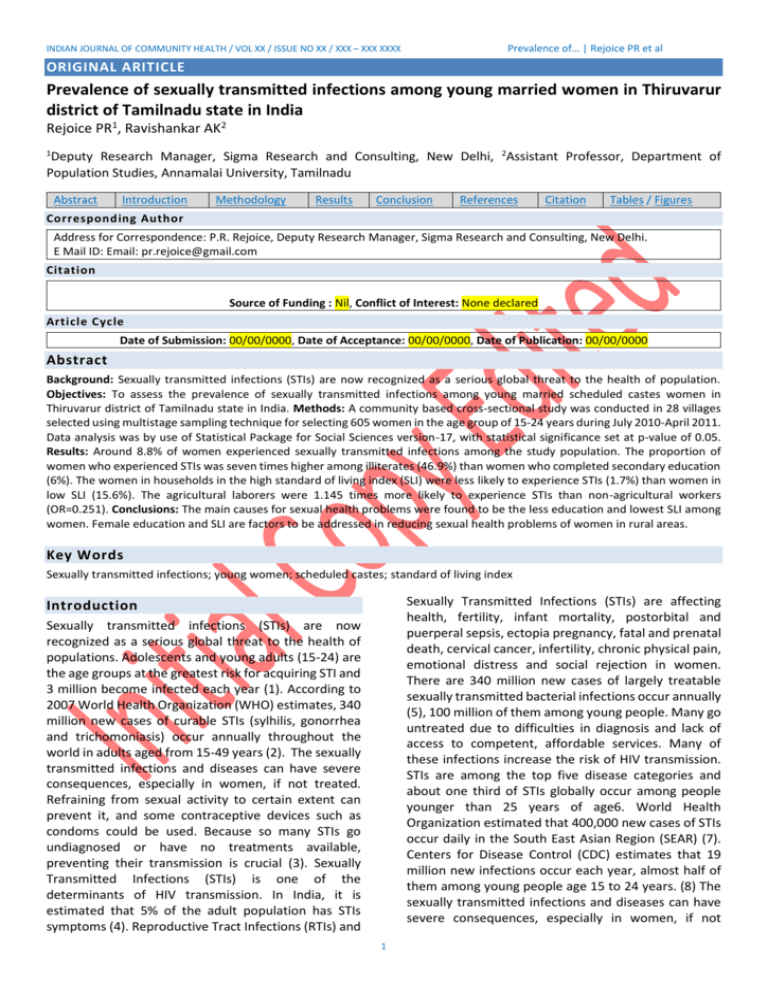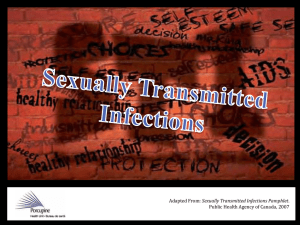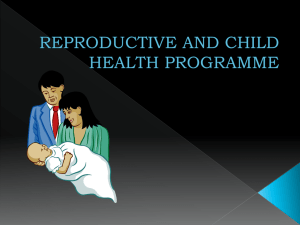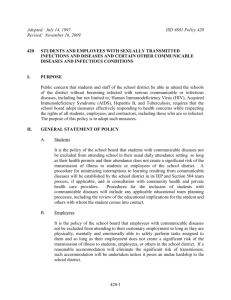Prevalence of*
advertisement

Prevalence of… | Rejoice PR et al INDIAN JOURNAL OF COMMUNITY HEALTH / VOL XX / ISSUE NO XX / XXX – XXX XXXX ORIGINAL ARITICLE Prevalence of sexually transmitted infections among young married women in Thiruvarur district of Tamilnadu state in India Rejoice PR1, Ravishankar AK2 1 Deputy Research Manager, Sigma Research and Consulting, New Delhi, 2Assistant Professor, Department of Population Studies, Annamalai University, Tamilnadu Abstract Introduction Methodology Results Conclusion References Citation Tables / Figures Corresponding Author Address for Correspondence: P.R. Rejoice, Deputy Research Manager, Sigma Research and Consulting, New Delhi. E Mail ID: Email: pr.rejoice@gmail.com Citation Source of Funding : Nil, Conflict of Interest: None declared Article Cycle Date of Submission: 00/00/0000, Date of Acceptance: 00/00/0000, Date of Publication: 00/00/0000 Abstract Background: Sexually transmitted infections (STIs) are now recognized as a serious global threat to the health of population. Objectives: To assess the prevalence of sexually transmitted infections among young married scheduled castes women in Thiruvarur district of Tamilnadu state in India. Methods: A community based cross-sectional study was conducted in 28 villages selected using multistage sampling technique for selecting 605 women in the age group of 15-24 years during July 2010-April 2011. Data analysis was by use of Statistical Package for Social Sciences version-17, with statistical significance set at p-value of 0.05. Results: Around 8.8% of women experienced sexually transmitted infections among the study population. The proportion of women who experienced STIs was seven times higher among illiterates (46.9%) than women who completed secondary education (6%). The women in households in the high standard of living index (SLI) were less likely to experience STIs (1.7%) than women in low SLI (15.6%). The agricultural laborers were 1.145 times more likely to experience STIs than non-agricultural workers (OR=0.251). Conclusions: The main causes for sexual health problems were found to be the less education and lowest SLI among women. Female education and SLI are factors to be addressed in reducing sexual health problems of women in rural areas. Key Words Sexually transmitted infections; young women; scheduled castes; standard of living index Sexually Transmitted Infections (STIs) are affecting health, fertility, infant mortality, postorbital and puerperal sepsis, ectopia pregnancy, fatal and prenatal death, cervical cancer, infertility, chronic physical pain, emotional distress and social rejection in women. There are 340 million new cases of largely treatable sexually transmitted bacterial infections occur annually (5), 100 million of them among young people. Many go untreated due to difficulties in diagnosis and lack of access to competent, affordable services. Many of these infections increase the risk of HIV transmission. STIs are among the top five disease categories and about one third of STIs globally occur among people younger than 25 years of age6. World Health Organization estimated that 400,000 new cases of STIs occur daily in the South East Asian Region (SEAR) (7). Centers for Disease Control (CDC) estimates that 19 million new infections occur each year, almost half of them among young people age 15 to 24 years. (8) The sexually transmitted infections and diseases can have severe consequences, especially in women, if not Introduction Sexually transmitted infections (STIs) are now recognized as a serious global threat to the health of populations. Adolescents and young adults (15-24) are the age groups at the greatest risk for acquiring STI and 3 million become infected each year (1). According to 2007 World Health Organization (WHO) estimates, 340 million new cases of curable STIs (sylhilis, gonorrhea and trichomoniasis) occur annually throughout the world in adults aged from 15-49 years (2). The sexually transmitted infections and diseases can have severe consequences, especially in women, if not treated. Refraining from sexual activity to certain extent can prevent it, and some contraceptive devices such as condoms could be used. Because so many STIs go undiagnosed or have no treatments available, preventing their transmission is crucial (3). Sexually Transmitted Infections (STIs) is one of the determinants of HIV transmission. In India, it is estimated that 5% of the adult population has STIs symptoms (4). Reproductive Tract Infections (RTIs) and 1 INDIAN JOURNAL OF COMMUNITY HEALTH / VOL XX / ISSUE NO XX / XXX – XXX XXXX Prevalence of… | Rejoice PR et al treated. Refraining from sexual activity to certain extent can prevent it, and some contraceptive devices such as condoms could be used. Because so many STIs go undiagnosed or have no treatments available, preventing their transmission is crucial. Risk can be reduced through the adoption of safer behaviors by individuals. Encouragement of these behaviors should then be incorporated into programs and policy (9). Selection of the Blocks: Thiruvarur district had totally ten blocks, which comprise 573 revenue villages. In the first stage, five blocks were selected which represent the geographical distribution of the study district. The selected blocks were Nannilam from north, Thiruvarur from east, Tiruturaipundi from south, Valangaiman from west and Mannargudi from central part of the study district. A profile of Scheduled Castes Population in India Selection of the Villages: There were 352 revenue villages in these selected five blocks. In the second stage, all the villages which had 50% of scheduled castes population were selected. I.e. 87 villages were selected. For covering entire block, one third of the villages (5/6 villages) were selected from each block by simple random sampling method. Thus, 28 villages were selected for the research purpose. The Indian caste system is a highly complex institution, though social institutions resembling caste in one respect or another are not difficult to find elsewhere, but caste is an exclusively Indian phenomenon. The “Scheduled Castes” is the legal and constitutional name collectively given to the groups which have traditionally occupied the lowest status in Indian society and the Hindu religion which provides the religious and ideological basis for a “disadvantaged” group, which was outside the caste system and inferior to all other castes10. At presents, the scheduled castes in India constitute around 16.8% of the total population. Almost one-third of them live below poverty line and do not have access even to the basic needs like food, clothing, and shelter and constitute major part of our labour force and are generally engaged in petty occupations like agriculture labour, construction work, hawking and other low grade jobs11. There is a general consensus that the health status of the scheduled castes population is very poor and worst (12). Aim and Objective: To assess the prevalence of sexually transmitted infections among young married scheduled castes women in Thiruvarur district of Tamilnadu state in India. Selection of the Respondents: In the third stage, house listing operation was carried out prior to the data collection to provide the necessary frame for selecting the households for the study. Totally 6376 houses were listed in all the five blocks. Identification of eligible young married women (15-24 years) in each household was the next step in the research. There were 1164 households with the target population (39 households had two couples). Totally 1203 women in the age group of 15-24 were identified. Systematic random sampling technique was applied for selecting 21/22 respondents from each village. In order to take care of non-response due to various reasons, an extra 10% of respondents were included in the sample. i.e. 661 respondents were selected for the interview. Totally, 605 respondents were completed the interview and 32 respondents declined to participate interview. The response rate of the research study was 91.5%. Aims & Objectives To assess the prevalence of sexually transmitted infections among young married scheduled castes women in Thiruvarur district of Tamilnadu state in India. Data Collection Tools: The respondents were assessed using a structured interviewer administered questionnaire which was pretested in Chidambaram Taluk near Annamalai University, about 102 km away from Thiruvarur district. Material and Methods Selection of the District: According to 2001 census, Thiruvarur district was the highest Scheduled Castes populated district and also backward district in Tamilnadu state. All women were living with their husbands and had given at least one birth one year prior to the survey. Data Analysis: Data analysis was carried out using the Statistical Package for Social Sciences (SPSS) version 17. Categorical variables were presented as frequencies and percentages. Bivariate analysis involved the use of the Chi-square and binary logistic regression test for assessing the significance of association between the women who experienced STIs and their socioeconomic and demographic variables. Study Design: A community based cross-sectional study was conducted in 28 villages selected using multistage sampling technique for selecting 605 women in the age group of 15-24 years during July 2010-April 2011. Ethical Approval: The syndicate review board at Annamalai University, Tamilnadu state, India has approved the research entitled “Reproductive and 2 Prevalence of… | Rejoice PR et al INDIAN JOURNAL OF COMMUNITY HEALTH / VOL XX / ISSUE NO XX / XXX – XXX XXXX Sexual Health status of Scheduled Castes Youth in Thiruvarur district, Tamilnadu, India” for the degree of Doctor of Philosophy (Ph D) in Population Studies with effect from July 2012. the present analysis, women who did not experience STIs were coded ‘0’ and those who experienced STIs were coded ‘1’. Independent variables chosen for the analysis were age of women, education of women, occupation of women, standard of living index, age at marriage, age at first birth, exposure to mass media weekly and distance of health care facility. Results All the respondents were asked whether they had experienced sexually transmitted infections (STIs) last six months prior to the study and the results are tabulated. The (Table 1) shows the percentage distribution of women by incidence of STIs. Overall, 8.8% of women experienced STIs among the study population. The result reveals that 4.6% of women reported that they suffer from ‘Discharge with unpleasant odor’ and another 3.6% of women experienced ‘Frequent and uncomfortable urination’. Meager portion of women stated that they experienced ‘Pain during sexual intercourse’ (3.1%) and very negligible portion respondents experienced ‘spotting after sexual intercourse’ (1%). Determinants of Prevalence of Sexually Transmitted Infections (STIs). (Table 2) shows the percentage distribution of women who had experienced sexually transmitted infections according to their socio-economic and demographic (SED) characteristics. The result shows that the proportion of women who experienced STIs was slightly higher among women in the age group 18-20 years (10.6%) than among older women (9.6% among 21-23 and 5.4% above 24 years). The proportion of highly educated women was less likely to experience STIs than less educated women. The proportion of women who experienced STIs was seven times higher among illiterates (46.9%) than among women who completed secondary education (6%). At the same time among women who completed higher secondary and above, no one reported that they had experienced any symptoms of STIs. Further, the analysis shows that women’s education had significantly associated with STIs (X2=73.23 and p= .000). The women who were working in non-agricultural sector experienced STIs (3.3%), whereas this proportion for women working in the agricultural sector was 8.6% and for non-working women were 14.2%. The findings indicate that the proportion of women in households in the high SLI was less likely to experience STIs (1.7%) than women in low SLI (15.6%). Women who experienced STIs were less among women who had more exposed to media (2.8%) than less exposed to media (13%). It is observed from the (Table 2) that women’s exposure to media had a strong association with the prevalence of STIs. (X2=19.34 and p= .000). Logistic Regression examining the effect of background characteristics on prevalence of STIs. (Table 3) shows the results of analysis made by binary logistic regression whether the women experienced STIs with background characteristics. In It is observed in the (Table 3) that education of women, occupation of women and standard of living index were statistically significant with prevalence of STIs. All other independent variables such as age of women, age at marriage, age at first birth, exposure to mass media, and distance of health care facility were not associated with the prevalence of STIs. The logistic regression analysis discloses that when compared with illiterate women, women with higher education (secondary and above level) were less likely to experience STIs (OR=0.183). It is noticed that agricultural laborers were 1.145 times more likely to experience STIs to the reference category (OR= 0.251) and non-workers the chances of getting STIs was less among non-agriculture category. It is also observed that the chance of getting STIs was less among women living in high standard of living index (OR=0.168) than among women living in medium SLI (OR=0.255) and the reference category (low SLI). Discussion This study overcame a key challenge to gaining a true community-based prevalence estimate of STIs: low response rate (91.5%) of women in five Blocks of Thiruvarur district who were eligible participated in the study. The present study reveals that 8.8% of women had experienced sexually transmitted infections among scheduled castes population in the study area. Many women and men suffer from reproductive tract infections (RTIs), including sexually transmitted infections (STIs). An estimated 340 million new cases of curable STIs occur each year, with 151 million of them in South and Southeast Asia. (13) Prevalence of sexually transmitted infections is detrained by number of factors. An association between pelvic inflammatory diseases (PID) women and husband extramarital sexual relation has been well documented. (14) The role of socioeconomic status in the development of STIs has been highlighted in a number of studies. (15, 16) A study from Accra among women with incomplete abortions also showed higher rates of bacterial colonization of the genital tract in women of lower socioeconomic status. (17) Low socioeconomic status is associated with greater high risk sexual behavior (18) and this would lead to a higher incidence of STIs. In an Ethiopian study, it was shown that 51% of women who came to an STI clinic 3 Prevalence of… | Rejoice PR et al INDIAN JOURNAL OF COMMUNITY HEALTH / VOL XX / ISSUE NO XX / XXX – XXX XXXX with symptoms had a confirmed clinical diagnosis. (19) Another study in India reported that 72% of women with STI symptoms had a clinically confirmed diagnosis. Despite these results it needs to be stressed that the presence of STI symptoms is not indicative of an STI diagnosis. Increasing age was found to protect against having STI symptoms. Sexually transmitted infections are diseases of young sexually active women so it is expected that older women would have fewer symptoms. (20) Prevalence of sexually transmitted infections is detrained by number of factors. An association between pelvic inflammatory diseases (PID) women and husband extramarital sexual relation has been well documented. (14) The present study reveals that 4.6% of women reported that they suffer from ‘Discharge with unpleasant odor’ and another 3.6% of women experienced ‘Frequent and uncomfortable urination’. The findings from the present study indicate that the proportion of women lives in the high SLI was less likely to experience STIs than women in low SLI. Women who experienced STIs were less among women who had more exposed to media than less exposed to media. As most of these illnesses progresses to chronic state and remain with the women for the rest of their lives, the importance of early detection and management becomes evident. Until now, a matter of concern that, little is known about the prevalence of Reproductive Tract Infections (RTIs) or STIs among women in developing countries such as India. A recent study of young married women aged 16-22 years in a rural community in Tamilnadu reports a very high level of morbidity. The study shows that more than half of the women were suffering from at least one or more RTI/STIs. Clinical examination also confirmed STIs among majority of them. (21) Adolescent women in India and Nepal report relatively high rates of gynecological morbidities, especially in the settings where girls have limited excess to adequate health care. (22) There are different sociodemographic economic, sexual, medical and behavioural factors related to STIs. The less educated women are more likely to affect from STIs due to lack of health care knowledge. Educated women are more capable to seek the source of treatment and they can use health care facilities more efficiently. Educated women can process health related information from mass media. They can make good investment in terms of health. standard of living index. The women in the study area were living with very poor standard of health and their issues related to health care getting intensified due to poverty, less educated, unemployment, lack of sanitation and hygiene, inadequate health care facilities and lack of proper gendered centric treatment. Media could again be used to promote female education especially in poor families. More information is required in rural area through mass media (Radio/Television). Recommendation In order to make better sexual health, the health worker needs to provide knowledge and treatment to high-risk behaviour women. Similarly, behaviour and communication change and proper STIs information are the best options to reduce the prevalence of STIs among women. There is need for female counselor at each health facility to discuss the STIs problem among women. The present study recommends that state policy makers should be introduced community intervention programmes to increase the awareness regarding sexual health issues among rural population. Authors Contribution Acknowledgement References 1. United Nations Programme on HIV/AIDS. Report on Facts about Sexually Transmitted Infections. 2004. 2. Sexually transmitted infections. World Health Organization. Available at: http://www.who.int/mediacentre/factsheets/fs110/en/print. html. 2007. 3. Reproductive Tract Infections and Sexually Transmitted Infections symptoms. An overview; www.popcouncil.org/pdfs/RTIF. 2005. 4. National Aids control programme phase-III (NACP). Ministry of Health and Family Welfare. Government of India. 2006. 5. World Health Organization. Global Prevalence and Incidence of Selected Curable Sexually Transmitted Infections: Overview and Estimates. Geneva: WHO. 2001. 6. World Health Organization. Young people and sexually transmitted diseases, Fact Sheet. Geneva: WHO. 1997. 7. World Health Organization. SEAR region update on STIs. New. Delhi, India: WHO. 2002; 5: 12-15. 8. Weinstock H, Berman S, Castes W. Sexually transmitted disease among American youth incidence and prevalence estimates, Perspective Sexual and Reproductive Health.2004; 36: 6-10. 9. Reproductive Tract Infections and Sexually Transmitted Infections symptoms: An overview, Population Council www.popcouncil.org/pdfs/RTIF. 2005. 10. Beteille. National Focus Group on Problems of Scheduled Cates and Scheduled Tribe Children, Census, Government of India, Office of the Registrar General and Census Commissioner. 2001. Conclusion Sexual diseases are common and preventable causes of morbidity and serious complications; thus primary prevention of STIs needs to be given high priority. The present study reveals that the prevalence of STIs was more common among illiterate women and less 4 INDIAN JOURNAL OF COMMUNITY HEALTH / VOL XX / ISSUE NO XX / XXX – XXX XXXX 11. Census, Office of the Registrar General and Census Commissioner, Government of India. 2001. 12. Ministry of Health and Family Welfare (MOHFW).Reproductive and Child Health Programme: Schemes for Implementation, Department of Family Welfare, New Delhi. 1997. 13. 14. World Health Organization (WHO). Global Prevalence and Incidence of Selected Curable Sexually Transmitted Infections: Overview and Estimates, Geneva. 2001. 15. Oomman, Nandini. A decade of research on Reproductive Tract Infections and other Gynecological Morbidity in India: Women’s Reproductive Health in India, New Delhi: Rawat Publication. 2000. 16. Radcliffe KW, Ahmad S, Gilleran G, Ross JD. Demographic and behavioural profile of adults infected with chlamydia: a case control study. Sexually Transmitted Infections.2001; 77 (4): 265-270. 17. Monteiro EF, Lacey CJ, Merrick D. The interrelation of demographic and geospatial risk factors between four common sexually transmitted diseases. Sexually Transmitted Infections. 2005; 81 (1): 41-46. 18. Lassey AT, Adanu RM, Newman MJ, Opintah JA. Potential pathogens in the lower genital tract at manual vacuum 19. 20. 21. 22. 23. Prevalence of… | Rejoice PR et al aspiration for incomplete abortion in Korle Bu Teaching Hospital, Ghana, East African Medical Journal. 2004; 81 (8): 398-401. Parikh S, Brennan P, Boffetta P. Metaanalysis of social inequality and the risk of cervical cancer, International Journal of Cancer. 2003; 105 (5): 687-691. Wolday D, Mariam Z, Mohammed Z, Meles H, Messele T, Seme W.Risk factors associated with failure of syndromic treatment of sexually transmitted diseases among women seeking primary care in Addis Ababa. Sexually Transmitted Infections. 2004; 80 (5):392-394. Prasad JH, Abraham S, Kurz KM, George V, Lalitha MK, John R.Reproductive tract infections among young married women in Tamil Nadu, India. International Family Planning Perspective. 2005; 31 (2): 73-82. Joseph A, Jasmin P, Abraham S. Gynecological problems among young married women in Tamil Nadu. Paper presented in an International Conference on Adolescent Reproductive Health: Evidence and Programme Implications for South Asia, Mumbai, India. 2000. JeJeebhoy, Shireen. Adolescent Sexual and Reproductive Behavior: A review of the evidence from India in Ramasubban and Jejeebhoy (eds.) Women’s Reproductive Health in India, New Delhi: Rawat Publication. 2000. ---------------------------x-------------------------- Tables TABLE NO. 1 DISTRIBUTION OF WOMEN WHO EXPERIENCED VA RIOUS SYMPTOMS OF ST LS (MULTIPLE RESPONSES) Number of Women n= 605 Experienced various symptoms of STIs Number % Discharge with unpleasant odor 28 4.6 Frequent and uncomfortable urination 22 3.6 Pain during sexual intercourse 19 3.1 Spotting after sexual intercourse 6 1.0 Women who experienced STIs 53 8.8 TABLE NO. 2 PERCENTAGE DISTRIBUTION OF WOMEN BY PREVALENCE OF STLS, ACCORDING TO BACKGROUND CHARACTERISTICS Women who experienced STIs Backgsround X2 P Characteristics Total Yes (%) No (%) Age 18 - 20 10.6 89.4 94 2.77 .250 21 - 23 9.6 90.4 364 24 years 5.4 94.6 147 Education Illiterate 46.9 53.1 32 73.23 .000 Primary education 17.9 82.1 56 Secondary education 6.0 94.0 467 Higher secondary+ 100.0 50 Occupation Non-workers 14.2 85.8 123 9.60 .008 Agricultural labourers 8.6 91.4 348 Non-agricultural 3.3 96.7 134 labourers Standard of living Low 15.6 84.4 234 index 40.99 .000 Medium 3.5 96.5 318 High 1.7 98.3 53 Age at marriage Less than 18 years 8.4 91.6 18 5.36 .147 18-19 years 10.4 89.6 307 20-21 years 5.6 94.4 238 22-23 years 100.0 42 5 Prevalence of… | Rejoice PR et al INDIAN JOURNAL OF COMMUNITY HEALTH / VOL XX / ISSUE NO XX / XXX – XXX XXXX Birth order Exposure to mass media Distance of health care facility First Second Third More frequently Less frequently Within one Km 2-3 Km 4 or more Km Total 8.2 9.1 9.7 2.8 13.0 7.6 10.3 9.0 8.8 91.8 90.9 90.3 97.2 87.0 92.4 89.7 91.0 91.2 365 207 33 252 353 78 171 356 605 4.35 .840 19.34 .000 3.53 .768 TABLE NO. 3 PERCENTAGE DISTRIBUTION OF W OMEN BY PREVALENCE O F STLS, ACCORDING TO BACKGROUND CHARACTERISTICS Background Variables Logistic Coefficient Significant value Odds Ratio Exp (β) (p) (β) Age Education Occupation Standard of living index Age at marriage Age at first birth Exposure to mass media Distance of health care facility 18-20 (ref) 21-23 1.000 24 years Illiterates (ref) Primary education Secondary education Higher secondary+ Non-workers (ref) Agricultural labourers Non-agricultural labourers Low level (ref) Medium level High level 18 or less years (ref) 19-20 21 or more 19 or less years (ref) 20-22 23 or more Less frequently (ref) More frequently Within 1 Km (ref) 1-3 Km 3 or more Constant 6 -.467 .285 .595 -.114 .863 -1.356 -3.116 -5.377 .035 .000 .000 1.034 -1.686 .009 .001 .892 1.000 .358 .244 .183 1.000 1.145 .251 -1.367 -2.684 .000 .000 -.619 -.595 .413 .519 -.071 .557 .825 .897 -.271 .325 -.457 -.367 3.302 .259 .310 .000 1.000 .255 .168 1.000 .538 .551 1.000 .931 .570 1.000 .763 1.000 .633 .693 27.173





